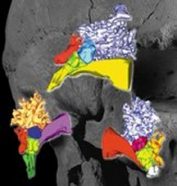Words of the distant past
Human ancestors may have been able to talk as far back as 350,000 years ago.
By Emily Sohn
Some people just won’t shut up. That’s probably been true for a long time—maybe even hundreds of thousands of years.
Computer reconstructions of ancient skulls show that our ancestors had ears built like ours as far back as 350,000 years ago. The ears of social mammals are typically designed to recognize sounds made by fellow species members. So, humanlike ears suggest humanlike speech, say researchers from Spain.
 |
|
Color images show reconstructions of ears in three Stone Age specimens from a Spanish site. A skull from that site appears in the background.
|
| Ignacio Martinez, et al. |
Anthropologists don’t know for sure when people started talking. To get a better idea, the new study focused on a group of fossils from a place in Spain called Sima de los Huesos. The fossils belong to a species called Homo heidelbergensis. Modern people did not evolve from H. heidelbergensis, but an ancient group called Neandertals might have.
Using a computerized scanner, the researchers measured ear structures on the remains. Then, they used information about living people to make three-dimensional computer models of what the ancient ears looked like. Finally, they measured how sound would pass through the model ears.
The results showed that the ears could handle almost exactly the same range of sounds that our ears can today. The researchers suggest that hearing and talking developed in a common ancestor shared by both Neandertals and modern people.
Other experts are more skeptical. Some studies have turned up conflicting results about the ears and vocal chords of Neandertals. And anyway, hearing could have evolved long before talking. The two don’t necessarily go together.
If it’s true that our ancestors could talk more than 350,000 years ago, that brings up another question. What kinds of things did they talk about?
Going Deeper:
Bower, Bruce. 2004. Stone Age ear for speech: Ancient finds sound off on roots of language. Science News for Kids 165(June 26):404. Available at http://www.sciencenews.org/articles/20040626/fob3.asp .
You can learn more about excavations and studies at the Sima de los Huesos site in Spain at www.ucm.es/info/paleo/ata/english/sites/y-sima.htm (Human Paleontology Group of the Universidad Complutense in Madrid).







